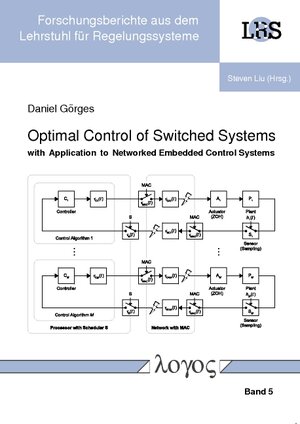
×
![Buchcover ISBN 9783832530969]()
Optimal Control of Switched Systems with Application to Networked Embedded Control Systems
von Daniel GörgesThis thesis addresses optimal control of discrete-time switched linear systems with application to networked embedded control systems (NECSs).
Part I focuses on optimal control and scheduling of discrete-time switched linear systems. The objective is to simultaneously design a control law and a switching (scheduling) law such that a cost function is minimized. This optimization problem exhibits exponential complexity. Taming the complexity is a major challenge. Two novel methods are presented to approach this optimization problem:
Periodic control and scheduling relies on periodic control theory. Both offline and online scheduling are studied. The optimization problem is solved based on periodic control and exhaustive search. The online scheduling solution can again be expressed as a PWL state feedback control law. Stability is guaranteed inherently. Several methods are proposed to reduce the online complexity based on relaxation and heuristics.
Part II focuses on optimal control and scheduling of NECSs. The NECS is modeled as a block-diagonal discrete-time switched linear system. Various control and scheduling codesign strategies are derived based on the methods from Part I regarding the structural properties of NECSs. The methods presented in Part I and II are finally evaluated in a case study.
Part I focuses on optimal control and scheduling of discrete-time switched linear systems. The objective is to simultaneously design a control law and a switching (scheduling) law such that a cost function is minimized. This optimization problem exhibits exponential complexity. Taming the complexity is a major challenge. Two novel methods are presented to approach this optimization problem:
Periodic control and scheduling relies on periodic control theory. Both offline and online scheduling are studied. The optimization problem is solved based on periodic control and exhaustive search. The online scheduling solution can again be expressed as a PWL state feedback control law. Stability is guaranteed inherently. Several methods are proposed to reduce the online complexity based on relaxation and heuristics.
Part II focuses on optimal control and scheduling of NECSs. The NECS is modeled as a block-diagonal discrete-time switched linear system. Various control and scheduling codesign strategies are derived based on the methods from Part I regarding the structural properties of NECSs. The methods presented in Part I and II are finally evaluated in a case study.


